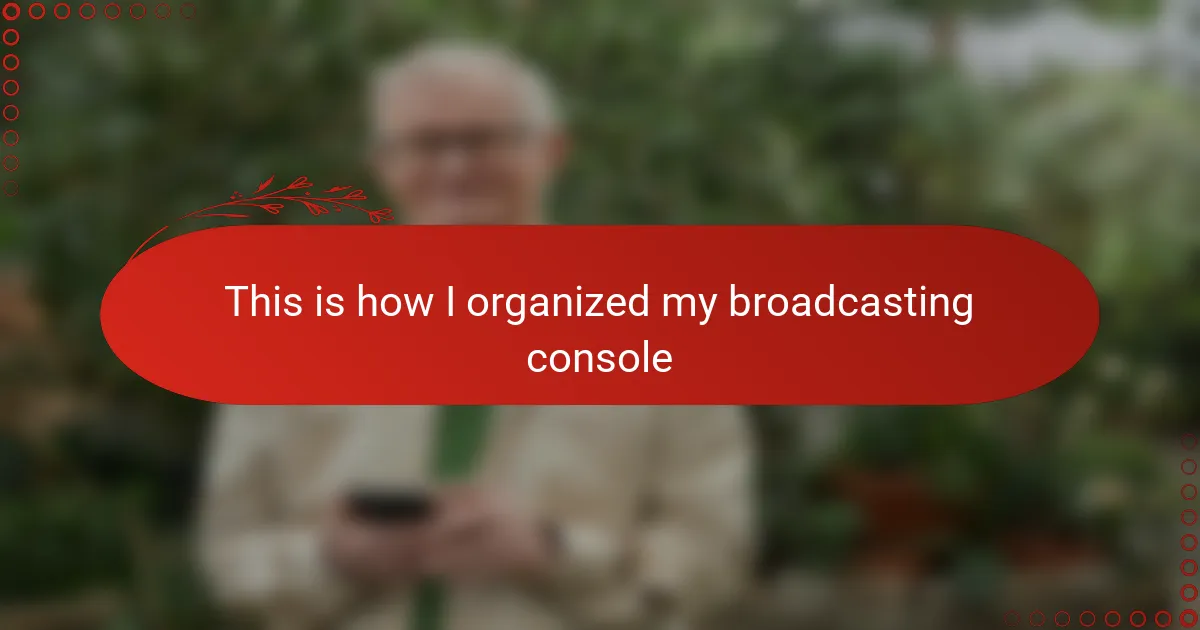Key takeaways
- Understanding broadcasting equipment enhances confidence and improves storytelling by allowing focus on creativity rather than troubleshooting.
- Effective planning of console layout and cable management streamlines workflow and reduces stress during live broadcasts.
- Customizing console controls and utilizing labeling and macros can significantly simplify audio source management and decision-making in fast-paced environments.
- Regular maintenance and systematic troubleshooting prevent issues during broadcasts and enhance overall performance and reliability of the equipment.
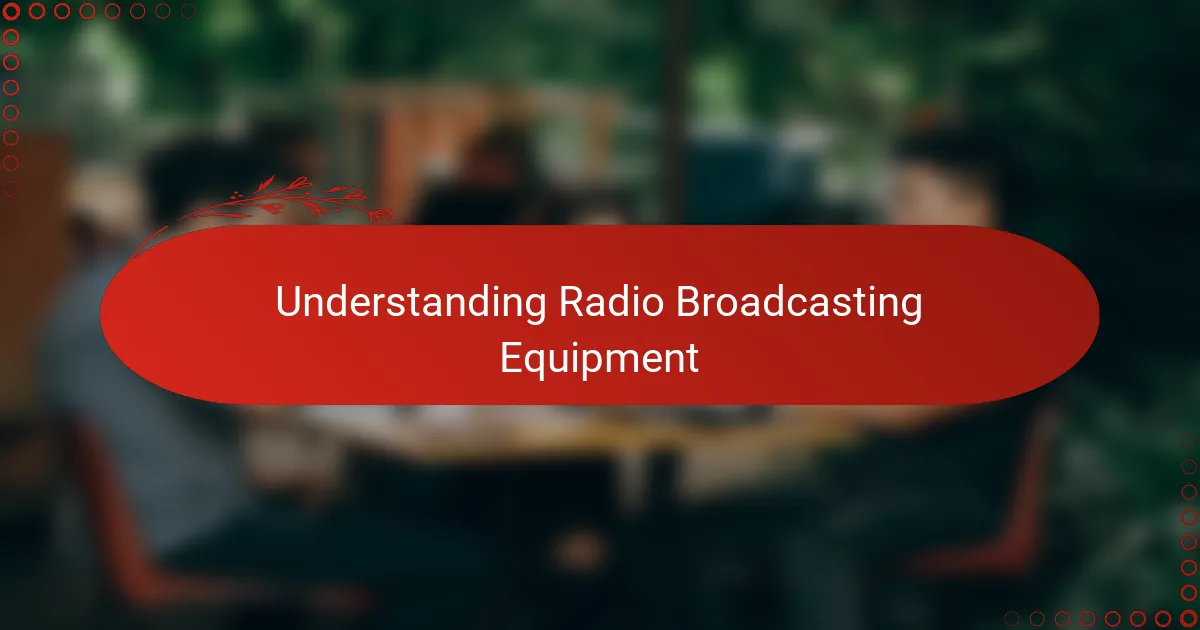
Understanding Radio Broadcasting Equipment
When I first faced my broadcasting console, the array of buttons, faders, and knobs felt overwhelming. But understanding each piece of equipment—the mixer, the microphone, the monitor speakers—transformed that confusion into confidence. Have you ever noticed how a simple adjustment on one fader can completely change the mood on air? That’s the magic of truly knowing your gear.
From my experience, the heart of a radio setup is the mixing console. It’s not just about controlling volume; it’s about carving out space for voices and sounds to blend perfectly. I remember the first time I realized how essential signal routing and input selection are—I felt like a conductor shaping a live orchestra. Isn’t that a powerful analogy for what radio really is?
Lastly, understanding equipment means appreciating the fine balance between technology and creativity. Knowing your tools lets you focus more on storytelling and less on troubleshooting. Have you ever been live and felt that seamless connection with your audience? For me, that’s only possible when I’m confident every piece of gear is exactly where I need it.
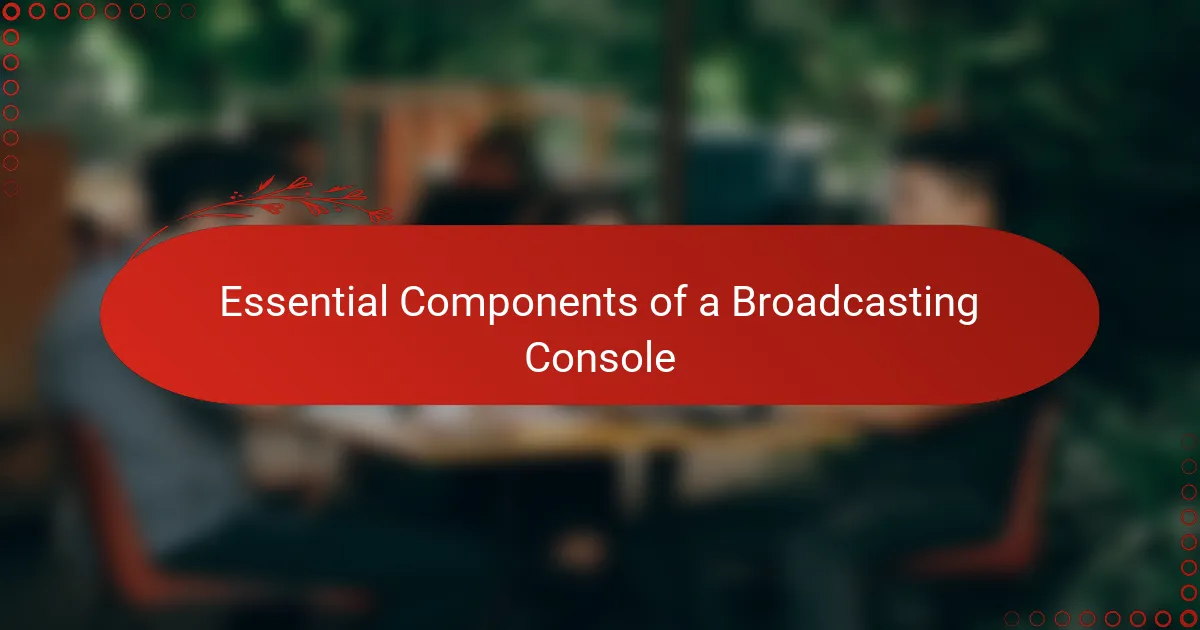
Essential Components of a Broadcasting Console
One of the essential components I relied on heavily is the microphone preamp. Without a clean and powerful preamp, even the best microphones can sound flat or noisy. I remember adjusting the preamp gain during a live segment—the clarity it brought to the host’s voice made me realize how critical this part truly is.
Equally important are the faders that control each channel’s volume. It’s fascinating how a slight nudge on a fader can bring a guest’s voice to the forefront or push background music just far enough back. When I first mastered smooth fader movements, it felt like I was shaping the whole listener experience in real time.
Don’t forget the routing buttons—the unsung heroes that decide where each signal goes. At first, they seemed complicated, but once I understood their role, I found myself effortlessly switching between inputs and outputs. Have you ever felt that thrill when you send the perfect sound effect live at just the right moment? That’s where routing comes into play, making every broadcast more dynamic.

Planning Your Console Layout
Planning the layout of my broadcasting console felt like arranging pieces of a puzzle that had to fit just right. I asked myself, which controls do I need immediately at my fingertips, and which can sit a bit farther away? This process helped me prioritize accessibility over aesthetic, ensuring every button and fader was exactly where I would instinctively reach during a live show.
It’s not just about positioning equipment; it’s about creating a workflow that matches how I think. For example, grouping all the microphone controls together made switching between hosts seamless and less stressful. Have you ever noticed how small adjustments become second nature when your setup complements your natural movements?
I also realized early on that planning involves anticipating chaos too. What happens when a caller suddenly joins or a surprise audio clip needs to play? By leaving space for quick overrides and emergency controls, I built flexibility into my console. This foresight transformed last-minute challenges into smooth transitions, making me feel more in control even during the most unpredictable broadcasts.
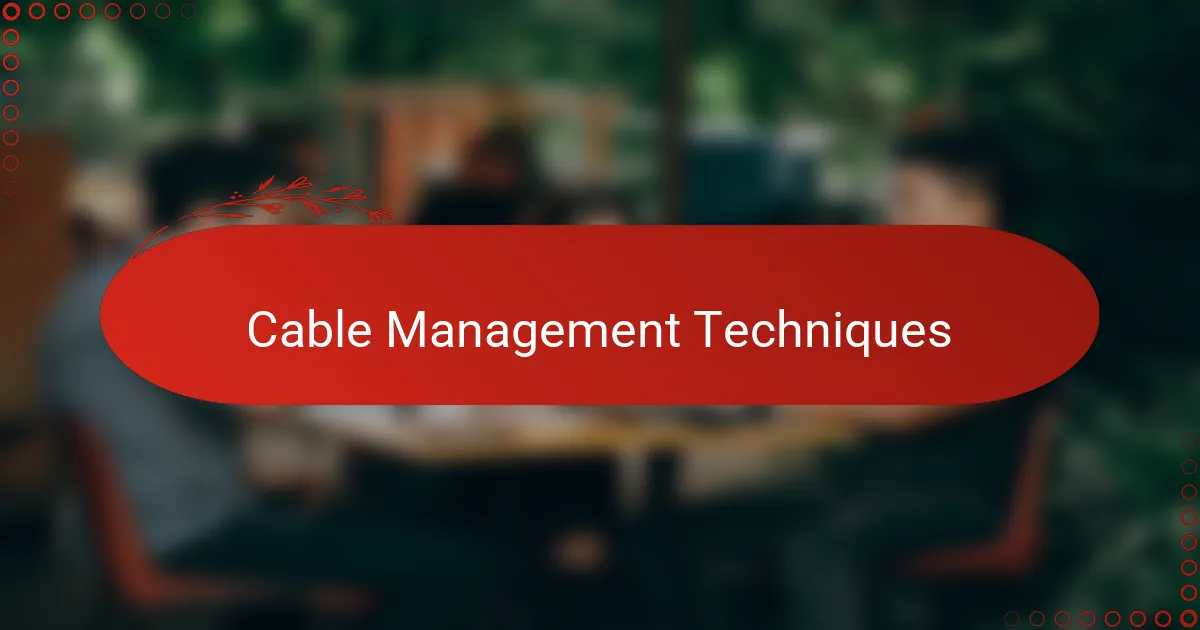
Cable Management Techniques
Managing cables felt like taming a wild jungle when I first set up my broadcasting console. I quickly learned that bundling cables together with Velcro straps doesn’t just make things look cleaner—it saves precious seconds when troubleshooting live. Have you ever scrambled to find the right cable under a mess of wires during a broadcast? That chaos is a stress I wanted to eliminate from day one.
Labeling each cable became my secret weapon. Using color-coded tags and clear labels on connectors gave me instant confidence. Instead of guessing which cable led where, I could trace any connection in a heartbeat. It might seem like extra work upfront, but trust me, it pays off massively when the pressure is on.
I also invested in cable trays and clips to keep everything securely in place, preventing accidental unplugging during hectic moments. It’s incredible how these small tools transform a cluttered desk into an efficient workspace. Do you know that feeling when all your focus can stay on the content because you’re not distracted by tangled cords? That’s the real beauty of good cable management.

Integrating Audio Sources Efficiently
Connecting all my audio sources efficiently was a game-changer. Early on, I struggled with juggling multiple inputs—microphones, phone lines, music players—and felt overwhelmed trying to switch between them quickly. Have you ever fumbled live because you couldn’t find the right input? That frustration pushed me to assign dedicated channels to each source, which instantly simplified the workflow.
I found that setting clear, consistent labeling and color-coding for each audio source dramatically reduced confusion. Once, during a fast-paced segment, I seamlessly brought in a caller’s line without missing a beat simply because I could visually spot and route the signal without hesitation. Isn’t it amazing how a little organization behind the scenes can make on-air moments feel so smooth?
Another trick I rely on is grouping related inputs logically on the console. For example, placing all microphone channels together and music sources on adjacent faders helps my hands move instinctively during live shows. This setup lets me focus on the content, not the console. Have you noticed how muscle memory makes switching between audio sources feel effortless after a bit of strategic arranging?
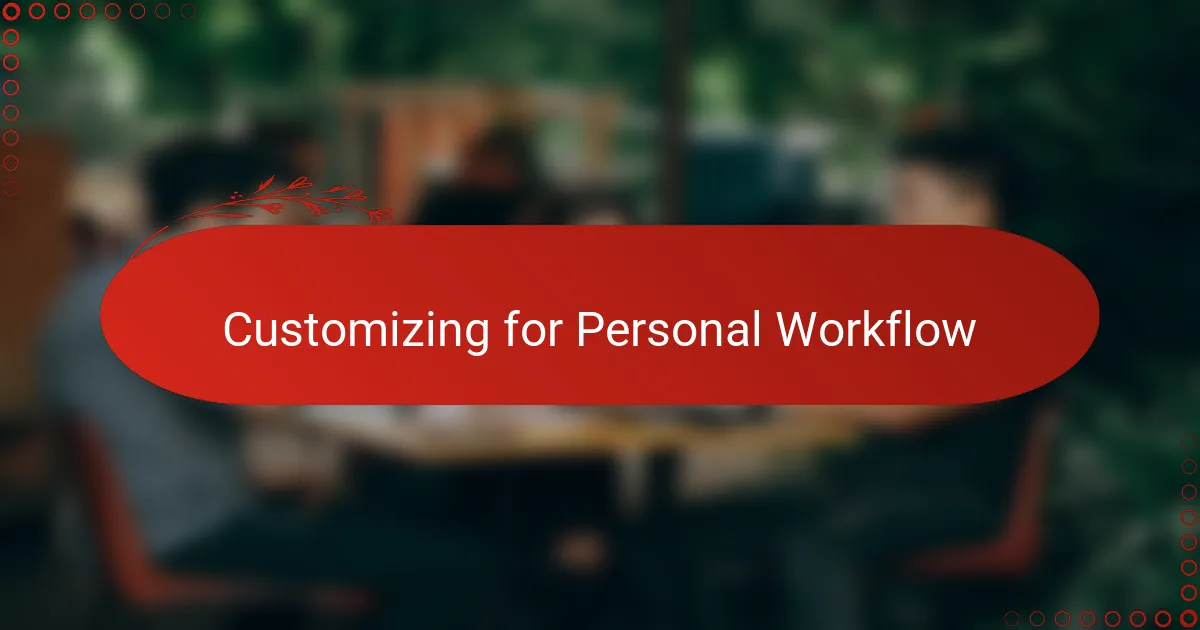
Customizing for Personal Workflow
Customizing my broadcasting console was like tailoring a suit—it had to fit my unique rhythm and style perfectly. I rearranged controls based on how I think and work during a show, placing my most-used faders and buttons exactly where my hands naturally fall. Have you ever experienced how a console that “fits” your workflow can reduce stress and boost your confidence on air?
One change that made a surprising difference was assigning specific colors and labels to different types of controls. This visual coding helped me instantly identify what I needed, even in the heat of a fast-paced broadcast. It’s funny how something as simple as color can streamline decision-making when every second counts, isn’t it?
I also integrated customizable macros—single buttons programmed to perform multiple actions at once. Initially, I hesitated, thinking it might complicate things, but soon I realized these shortcuts were lifesavers, especially when juggling live callers or switching between audio sources. Don’t you love it when technology works with you, not against you? That’s exactly what these personalized tweaks achieved for me.
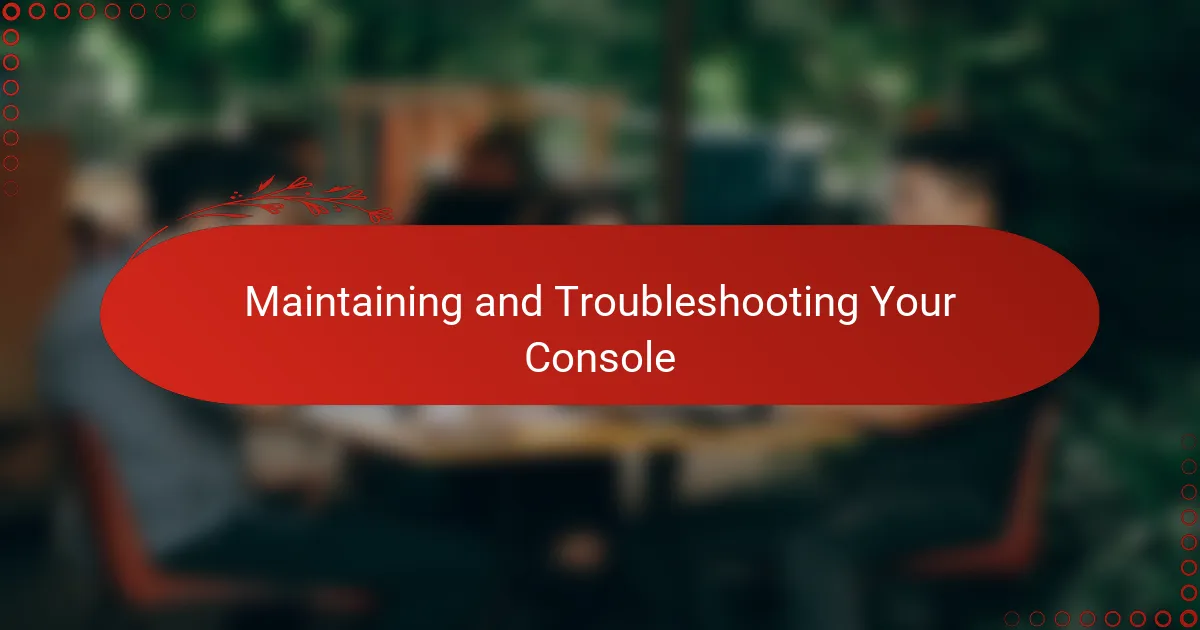
Maintaining and Troubleshooting Your Console
Keeping my broadcasting console in top shape has been a mix of routine care and quick problem-solving. I learned early on that dusting off the surface and gently cleaning faders isn’t just about looking neat—it actually prevents scratchy noises and sticky controls during shows. Have you ever experienced that frustrating moment when a stubborn fader refuses to move? Regular maintenance saved me from those live mishaps more than once.
Troubleshooting, on the other hand, sometimes feels like detective work. When I faced unexpected audio dropouts or distorted sound, I’d methodically check connections, mute switches, and software settings one by one. There’s a certain satisfaction in pinpointing the exact cause—it’s like solving a puzzle under pressure. Have you noticed how staying calm and systematic in these moments can turn chaos into control?
One trick I swear by is logging every issue and its fix. Early in my journey, I treated errors as annoyances, but documenting them helped me spot patterns and avoid repeat problems. Now, before a live session, reviewing past notes feels like a secret weapon, giving me peace of mind that I’m prepared for any technical curveballs. Doesn’t that kind of preparedness make you feel more confident behind the console?
